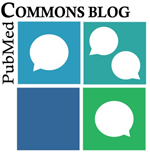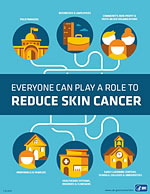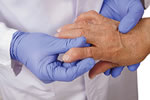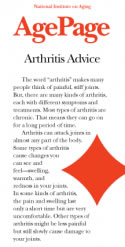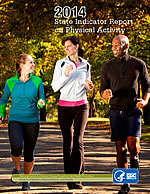Spotlight
Letter from Dr. Stephen I. Katz: Advances and Insights From Rare Disease Research
The NIAMS conducts and supports basic, translational and clinical research on some of the most debilitating diseases affecting the nation’s health. Although a number of these diseases are very common, many of them are rare, affecting only a few thousand people worldwide. In this month’s letter, I will highlight several examples of NIAMS-funded research on rare diseases. The importance of studying these conditions cannot be overstated. Research on rare diseases has tremendous potential to improve the lives of affected individuals. It also substantially advances our understanding of fundamental biology and therefore often provides insights that can be applied to other diseases that affect larger numbers of people.
Image: Stephen I. Katz, M.D., Ph.D.
News
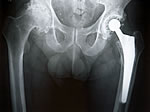 Commonly Prescribed Blood Thinner Associated With Higher Risk of Post-Surgery Complications
Commonly Prescribed Blood Thinner Associated With Higher Risk of Post-Surgery Complications
A blood thinner commonly prescribed to prevent blood clots after a hip or knee replacement is associated with an increased risk of post-surgery bleeding or infection, according to a study conducted by orthopaedic researchers at the NIAMS. The study was recently published in the journal PLOS One.
Image: X-ray of a hip replacement.
NIH Launches New Program To Find Potential Drug Targets: Researchers Will Explore Poorly Understood Genes, Build Information Repository
National Institutes of Health (NIH) leaders have announced a new collaborative initiative to improve human health by exploring poorly understood genes that have the potential to be modified by medicines. The effort is part of an NIH Common Fund three-year pilot project called Illuminating the Druggable Genome. For the initial phase of the program, the NIH has awarded $5.8 million to eight institutions.
NIH Programs To Focus on Emerging Areas of Science
Scientific areas ripe for targeted investments in technology development and research to improve health are the focus of new programs of the NIH Common Fund. The programs include work to facilitate the study of how sugar modifications affect proteins, to understand the arrangement of DNA within cells in four dimensions and to enable the development of new therapies that allow control of organ function through manipulation of nerves.
More on the Physician-Scientist Workforce
A major report on the Physician-Scientist Workforce was presented and discussed at the most recent Advisory Council to the Director meeting. It was a highly anticipated followup to the Biomedical Workforce report from a couple of years earlier. Dr. Sally Rockey follows up on an earlier post with a closer look at some key points presented by the Physician-Scientist Workforce working group.
NIH Director’s Blog
PubMed Commons: Catalyzing Scientist-To-Scientist Interactions
Today’s scientists find it tough to keep up with all of the latest journal articles, innovative methods and interesting projects of colleagues in their fields. That’s understandable, because there are tens of thousands of journals, hundreds of conferences in major fields, dozens of emerging technologies and huge geographic distances separating researchers who may share common interests. But science is increasingly a team sport—and it’s important to provide scientists with as many avenues as possible through which to interact, including commenting on each other’s work. To encourage such exchanges, NIH’s National Center for Biotechnology Information(NCBI) recently developed PubMed Commons, a resource that gives researchers the opportunity to engage in online discussions about scientific publications 24/7.
Cancer Cachexia: Might This Molecule Hold the Key?
No matter how much high-calorie food they eat or nutritionally fortified shakes they drink, many people with cancer just can’t seem to maintain their body weight. They lose muscle and fat, sometimes becoming so weak that they can’t tolerate further treatment. Called cachexia, this progressive wasting syndrome has long troubled patients and their families, as well as baffled scientists searching for ways to treat or perhaps even prevent it.
Image: Structure of parathyroid hormone-related protein (PTHrP), which has been implicated in cancer-related cachexia.
Other Federal News
FDA Expands Approval of Drug To Treat Pompe Disease to Patients of All Ages: Removes Risk Mitigation Strategy Requirements
The U.S. Food and Drug Administration (FDA) announced the approval of Lumizyme (alglucosidase alfa) for treatment of patients with infantile-onset Pompe disease, including patients who are less than 8 years of age. In addition, the Risk Evaluation and Mitigation Strategy known as the Lumizyme ACE (Alglucosidase Alfa Control and Education) Program is being eliminated. Pompe disease is a rare genetic disorder and occurs in an estimated 1 in every 40,000 to 300,000 births. Its primary symptom is heart and skeletal muscle weakness, progressing to respiratory weakness and death from respiratory failure.
FDA Takes Steps To Help Ensure the Reliability of Certain Diagnostic Tests: Reinforces Agency’s Commitment to Fostering Personalized Medicine
The FDA took important steps to ensure that certain tests used by health care professionals to help diagnose and treat patients provide accurate, consistent and reliable results.
Surgeon General’s Call to Action To Prevent Skin Cancer
Skin cancer, the most commonly diagnosed cancer in the United States, is a major public health problem that requires immediate action, according to a new Call to Action released by the U.S. Surgeon General. Even though most skin cancers can be prevented, rates of skin cancer, including melanoma, are increasing in the United States. Nearly 5 million people in the United States are treated for skin cancer every year, at an average annual cost of $8.1 billion. It is also one of the most common types of cancer among U.S. teens and young adults.
NEW PUBLICATIONS
Rheumatoid Arthritis: When Your Immune System Attacks Your Body—NIH MedlinePlus Magazine Summer 2014 Issue
Rheumatoid arthritis is a disease that affects the joints. It causes pain, swelling and stiffness. If one knee or hand has rheumatoid arthritis, usually the other does too. This disease often occurs in more than one joint and can affect any joint in the body. People with this disease may feel sick and tired, and they sometimes get fevers.
Worried About Arthritis? Advice From the National Institute on Aging (NIA)
In addition to the NIHSeniorHealth website and other publications, the NIA has an Arthritis Advice AgePage with information on common kinds of arthritis, treatments and lifestyle changes to help you with arthritis. You can download or order free copies of the Arthritis Advice AgePage for yourself, your friends or groups that may want to know more about living with arthritis. To order free copies, go to the English or Spanish Arthritis Advice AgePage and look for the shopping cart icon or call the NIA Information Center at 1-800-222-2225.
Centers for Disease Control and Prevention’s State Physical Activity Indicator Report Available Online
More than half of youth in the United States have access to parks or playground areas, recreation centers, boys’ and girls’ clubs and walking paths or sidewalks in their neighborhoods, according to a new report, 2014 State Indicator Report on Physical Activity [PDF - 2.8 MB]. The report also finds that 27 states have adopted policies that formalize their intent to plan, design and maintain streets so they are safe for all users including pedestrians, bicyclists, motorists, transit riders and those in wheelchairs. The report includes physical activity behavior, environment and policy information for each state.
NIH Research Matters
NIH Research Matters is a review of NIH research from the Office of Communications and Public Liaison, Office of the Director, NIH.
Cool Temperature Alters Human Fat and Metabolism
Humans have several types of fat. White fat stores extra energy. Too much white fat, a characteristic of obesity, increases the risk of type 2 diabetes and other diseases. Brown fat, in contrast, burns chemical energy to create heat and help maintain body temperature. Researchers have previously shown that, in response to cold, white fat cells in both animals and humans take on characteristics of brown fat cells.
NIH News in Health
Read practical health information in NIH News in Health, which is reviewed by the NIH’s medical experts and is based on research conducted either by the NIH’s own scientists or by its grantees at universities and medical schools around the country.
MEETINGS
September NIAMS Advisory Council Meeting
The NIAMS Advisory Council Meeting will be held September 8, 2014, in Building 31, 6th Floor, C Wing, Conference Room 6, NIH Campus. A meeting agenda will be posted as soon as it is available.

NIH Blood and Marrow Transplant (BMT) Consortium: 20th Anniversary Allogeneic Stem Cell Transplant at NIH Celebration
Thursday, September 11, 2014: Scientific Program: Advances in the Practice of Stem Cell Transplantation, 8 a.m. to 5 p.m.
Friday, September 12, 2014: Survivorship Program: Patient and Caregiver Perspective, 12 to 4 p.m.
NIH Campus, Clinical Center (Building 10), Masur Auditorium
Cost: Free
Registration
NIH Pathways to Prevention Workshop: The Role of Opioids in the Treatment of Chronic Pain
Monday, September 29, 2014, from 8:30 a.m. to 5 p.m.
Tuesday, September 30, 2014, from 8:30 a.m. to 1 p.m.
NIH Campus, Natcher Auditorium (Building 45)
Cost: Free
Draft Agenda
Registration
Register to view the live videocast.
WALS Returns in September
The 2014–2015 Wednesday Afternoon Lecture Series (WALS) starts September 3 with Andrew Feinberg, M.D., M.P.H., director of the Center for Epigenetics at Johns Hopkins School of Medicine. When completed, the 2014–2015 schedule will be posted on the WALS website.
NIH Science Lectures and Events Available via Internet
The NIH hosts a number of science seminars and events that are available online through real-time streaming video. You can watch an event at your convenience as an on-demand video or a downloadable podcast. Most events are available to all; a few are broadcast for the NIH or the HHS and are marked as such. See additional details on events.
FUNDING ANNOUNCEMENTS
NIAMS Announcements
Ethical, Legal and Social Implications (ELSI) of Genomic Research Regular Research Program (R01)
(PA-14-276)
Letter of Intent Receipt Date: Not applicable
Application Receipt Dates: Standard dates apply
Ethical, Legal and Social Implications (ELSI) of Genomic Research Small Research Grant Program (R03)
(PA-14-277)
Letter of Intent Receipt Date: Not applicable
Application Receipt Dates: Standard dates apply
Ethical, Legal and Social Implications (ELSI) of Genomic Research Exploratory/Developmental Research Program (R21)
(PA-14-278)
Letter of Intent Receipt Date: Not applicable
Application Receipt Dates: Standard dates apply
Discovery of in vivo Chemical Probes (R01)
(PAR-14-279)
Letter of Intent Receipt Date: Not applicable
Application Receipt Dates: Standard dates apply
High Throughput Screening (HTS) To Discover Chemical Probes (R21)
(PAR-14-283)
Letter of Intent Receipt Date: Not applicable
Application Receipt Dates: Standard dates apply
High Throughput Screening (HTS) To Discover Chemical Probes (R01)
(PAR-14-284)
Letter of Intent Receipt Dates: 30 days prior to the application due dates
Application Receipt Dates: Standard dates apply
NIH Common Fund Initiative Announcement
NIH Transformative Research Awards (R01)
(RFA-RM-14-003)
Letter of Intent Receipt Date: September 10, 2014
Application Receipt Date: October 10, 2014
Other Funding Announcements
NIH Announces Change in Policy Requirements for Activation Notices for Fellows Sponsored by Foreign and Federal Institutions
(NOT-OD-14-101)
Revised Timeline for Administrative Changes to NIH Domestic Awards To Transition to Payment Management System Subaccounts
(NOT-OD-14-103)
Request for Information: Shared Instrumentation Grant Program (S10)
(NOT-OD-14-104)
Extramural Loan Repayment Program for Clinical Researchers (LRP-CR)
(NOT-OD-14-105)
Extramural Clinical Research Loan Repayment Program for Clinical Researchers From Disadvantaged Backgrounds (LRP-IDB)
(NOT-OD-14-106)
Extramural Loan Repayment Program for Pediatric Research (LRP-PR)
(NOT-OD-14-107)
Extramural Loan Repayment Program for Contraception and Infertility Research (LRP-CIR)
(NOT-OD-14-108)
Extramural Loan Repayment Program for Health Disparities Research (LRP-HDR)
(NOT-OD-14-109)


